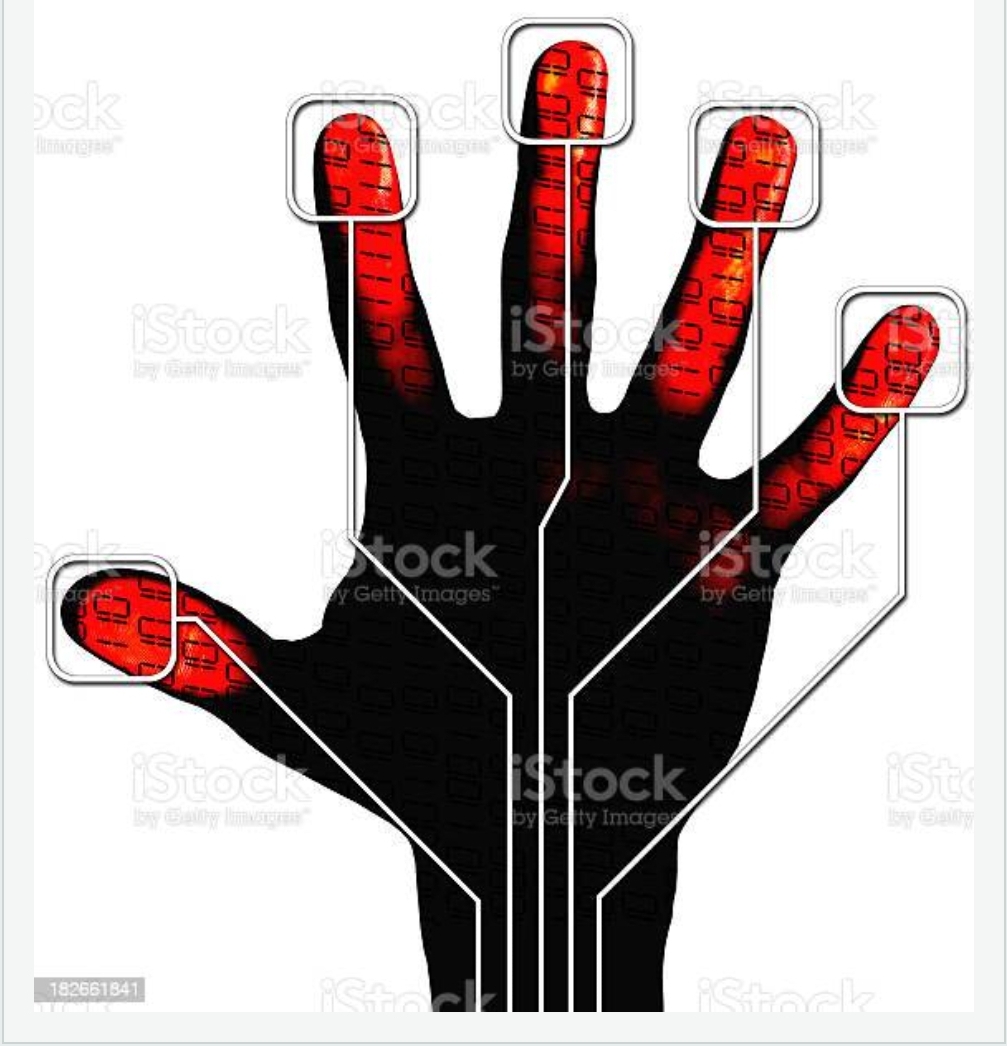Palm vein authentication compares the pattern of veins in the palm of the individual being authenticated to a pattern stored in a database.
According to Fujitsu study, vascular patterns are unique to each individual – even identical twins have different patterns. Because vascular patterns are internal to the body, they cannot be taken by photography, voice recording, or fingerprints, making this biometric authentication approach more secure than others.

Authentication principles for vascular patterns
The blood’s haemoglobin is oxygenated in the lungs and then transported to the body’s tissues via the arteries. The deoxidized haemoglobin returns to the heart through the veins after releasing its oxygen to the tissues. The absorption rates of these two kinds of haemoglobin are different1. In the near-infrared region, deoxidized haemoglobin absorbs light with a wavelength of about 760 nm. Unlike the image seen by the human eye, when the palm is lit with near-infrared light, the deoxidized haemoglobin in the palm veins absorbs the light, lowering the reflection rate and causing the veins to appear as a black pattern.
In vein authentication based on this principle, the authentication region is photographed using near-infrared light, and the vein pattern is retrieved and registered using image processing. The pre-registered vein pattern of the person being authenticated is then compared to the vein pattern of the person being authenticated.
Benefits of Using Your Palm
- Vein authentication can also be done utilising the vascular pattern on the back of the hand or a finger, in addition to the palm. The palm vein pattern, on the other hand, is the most complicated and covers the most surface area. The palm’s vascular system is easier to photograph since it lacks hair. In comparison to the fingers or the back of the hand, where the colour might darken in some locations, the palm has no notable changes in skin tone.
Reflection photography’s benefits
- Veins can be photographed using two methods: reflection and transmission. Fujitsu uses the reflection technique. The reflection approach illuminates the palm and photographs the light reflected back, whereas the transmission method photos light passing directly through the hand. After diffusion through the hand, both types catch the near-infrared light emitted by the region utilised for identification. The way the reflection and transmission methods adapt to variations in the hand’s light transmittance is a key distinction. When the body cools as a result of a lower ambient temperature, the blood vessels (particularly the capillaries) contract, reducing blood flow across the body.
- This enhances the hand’s light transmittance, allowing more light to travel through it. The hand can become saturated with light and light can readily pass through it if the transmittance is too high. This results in a lighter, less-contrasted image that makes it difficult to see the vessels when using the transmission approach. A high light transmittance, on the other hand, has no effect on the level or contrast of reflected light. As a result, even when the hand/body is cool, the vessels can be plainly seen using the reflection approach.
- The two approaches’ system setups are also different. The reflection approach illuminates the palm while also taking images that are reflected back from it, allowing the illumination and photography components to be placed in the same location.
- A high light transmittance, on the other hand, has no effect on the level or contrast of reflected light. As a result, even when the hand/body is cool, the vessels can be plainly seen using the reflection approach. The two approaches’ system setups are also different. The reflection approach illuminates the palm while also taking images that are reflected back from it, allowing the illumination and photography components to be placed in the same location.
- The lighting and photography components, on the other hand, must be located in distinct locations since the transmission method photographs light that goes through the hand. This makes it difficult to integrate the system into smaller devices like notebook computers or cell phones.
- Fujitsu did a thorough analysis of the required optical components in order to minimise the sensor’s size and make it more suited for embedded applications.
- Hygiene issues and psychological barriers are reduced because to the completely frictionless design.
- Fujitsu was the first to build a palm vein authentication device that is totally contactless.
- Authentication using this device is as simple as placing your hand over the vein sensor.
- Because this device is fully contactless, it can be used in situations where high levels of hygiene are necessary, such as public venues or medical institutions. It also removes any apprehension people may have about coming into contact with something that has already been touched by others.
- Authentication with high precision Fujitsu has confirmed that the system has a false acceptance rate of less than 0.00008 percent and a false rejection rate of 0.01 percent when the hand is held over the device three times during registration, with one retry for comparison during authentication, using data from 140,000 palms from 70,000 people.
The device’s capacity to perform personal authentication was also confirmed using the following methods:
1) statistics from people aged 5 to 85, including those working in various occupations, based on demographics published by the Statistics Bureau’s Statistics Center;
2) data on foreigners living in Japan according on United Nations world demographics;
3) data collected in a variety of everyday settings, such as after consuming alcohol, bathing, walking outside, and waking up.
Suruga Bank3 announced its “Bio-Security Deposit” — the world’s first financial service to deploy PalmSecure — in July 2004 to protect customer security. This service provides consumers with strong security using vein authentication, does not require a bankcard or passbook, and restricts withdrawals from branches other than the registered branch and ATMs, reducing the risk of fraudulent transactions. Customers visit a bank and have their palm veins photographed at the counter to open a Bio-Security Deposit account. Palm vein data is only stored on the vein database server at the branch office where the account is opened to ensure secure data management.
Financial solution product development
In recent years, the financial harm caused by unauthorised withdrawals of money utilising identity spoofing with false bankcards has risen significantly, and it has become a big social problem2. As a result, the number of lawsuits filed by victims of identity theft against financial institutions for failing to control information used for personal identification has risen dramatically.
On May 1, 2005, Japan’s “Act for the Protection of Personal Information” went into effect, and financial institutions have been focusing on biometric authentication in conjunction with IC (smart) cards as a way to strengthen the security of personal identification.
Depending on where the registered vein patterns are maintained, vein authentication can provide two types of financial solutions. The vein patterns are stored on the server of a client-server system in one approach. This system has the advantage of being able to manage vein patterns and do comparison processing all in one place. The alternative version stores a user’s vein pattern on an IC card, which is advantageous since users have control over who has access to their vein pattern. Suruga Bank’s financial solutions are based on the server type, while The Bank of Tokyo-Mitsubishi employs the IC card system.
The Bank of Tokyo-Mitsubishi4 released their “Super-IC Card Tokyo-Mitsubishi VISA” in October 2004. This card combines the features of a bankcard, credit card, electronic money, and palm vein authentication into one convenient package. The Bank of Tokyo-Mitsubishi has reduced the biometric verification techniques acceptable for financial transactions to palm veins, finger veins, and fingerprints from a technical and user-friendly standpoint. The bank then mailed 1,000 consumers a questionnaire and surveyed 1,000 more customers who utilised devices in their branches. Finally, the bank decided to utilise PalmSecure because it was the technology that received the most support in the survey.
The customer’s palm vein data and vein authentication methods are stored on the Super-IC Card, which performs vein authentication on its own.
The customer’s palm vein data and vein authentication methods are stored on the Super-IC Card, which performs vein authentication on its own. Because the customer’s information is not stored with the bank, this technique is favourable.
When a consumer requests a Super-IC card, the bank mails it to the customer’s address. The consumer must bring the card, his or her passbook, and seal to the bank counter to activate the palm vein authentication function, where the customer’s vein information is registered on the card. After registering, the user can use palm vein authentication and a corresponding PIN number to make transactions at that branch’s counter and any ATM.
ADVANTAGES
Vein authentication can also be done utilising the vascular pattern on the back of a hand or a finger, in addition to the palm. The palm vein pattern, on the other hand, is the most complicated and covers the most area, and because the palm has no hair, photographing its vascular pattern is easy. In comparison to the fingers and back of the hand, where the colour might darken in some locations, the palm has no notable changes in skin tone.
APPLICATIONS
For added security, palm vein authentication technology is employed in a variety of settings. The following are some of the most common applications.
- ATM
Customers that use vein certification do not need a bank card or a pass book to use this amenity, which provides great security. It also prevents withdrawals from branches other than the registered branch and ATMs, reducing the danger of unauthorised transactions. Customers visit a bank and have their palm veins photographed at the counter to open a Bio-Security Deposit account. To ensure secure data management, the palm vein data is stored only on the vein data base server at the branch office where the account is opened. Later on, a card system was implemented. This card combines the features of a bankcard, credit card, electronic money, and palm vein authentication into one convenient package.
The card contains the customer’s palm vein data as well as palm authentication algorithms, and it performs vein authentication independently. Because the consumers’ information is not saved with the bank, this technique is favourable.
- PCs are personal computers.
Palm vein technology can be used in personal computers by incorporating a vein sensor into the mouse. When the system receives electricity, the mouse receives power as well, and the sensor in the mouse will be ready to detect palm veins. When a person places his or her palm on the sensor, the veins are detected, and if they match a previously registered vein, the system authorises the individual to use it. This automation can also be used to lock folders in order to retain privacy.
- In Libraries And Hospitals
A Japanese public library will be the first in the world to adopt palm-vein biometrics as a replacement for traditional library cards. To secure physical access to its Department of Planning, Information, and Management, the University of Tokyo hospital has received a contactless palm vein authentication device.
- Authentication
We can use this Palm vein technology in front of our homes to maintain great range security by registering the veins of our family members and relatives, which is not achievable with other technologies. Before front doors, the Japanese used this technology to achieve great levels of protection.
Conclusion
Because the pattern of veins in the palm is complicated and unique to each individual, this technique is both extremely secure and highly accurate.
It also has a sanitary advantage over other biometric authentication systems because to its contactless characteristic. This article also goes over some of the financial solutions and commercial applications that have been created using this technology for the general market. Many of our clients have given this device a positive review and have had no psychological issues with it. This has prompted us to begin developing new products for a variety of applications, beginning with financial solutions and progressing to access control and login units.
To broaden the application range of our authentication solutions, Fujitsu will continue to focus on lowering the size of components and programmes. We’ll also create products for North America, Europe, Asia, and other international markets, and we’ll keep pushing for international standardisation of this technology.


